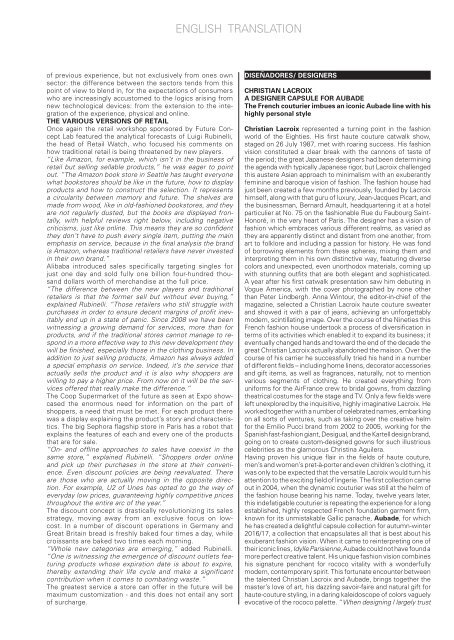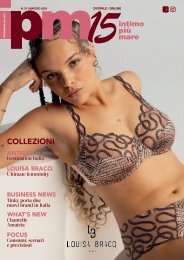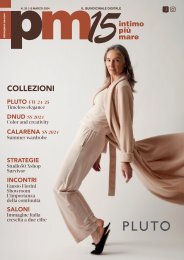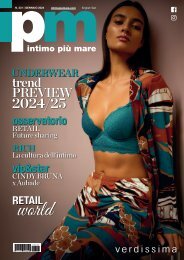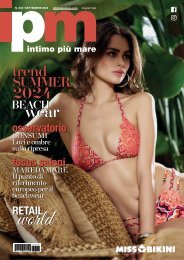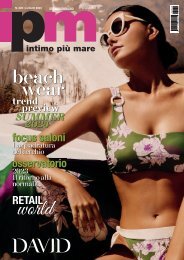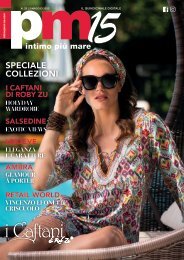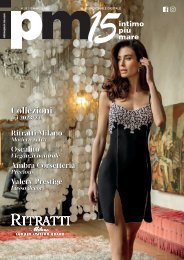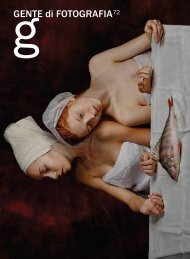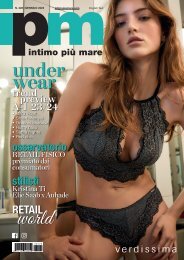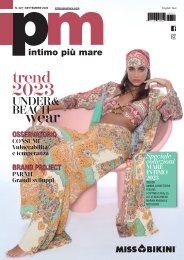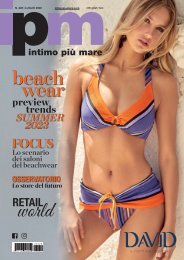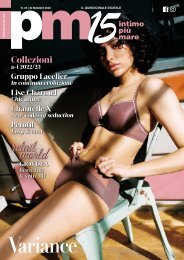Blint n° 75 - Enero 2016
Revista líder en España / Tendencias innovadoras del sector para boutiques, responsables de compras de comercios mayoristas, detallistas y profesionales.
Revista líder en España / Tendencias innovadoras del sector para boutiques, responsables de compras de comercios mayoristas, detallistas y profesionales.
Create successful ePaper yourself
Turn your PDF publications into a flip-book with our unique Google optimized e-Paper software.
ENGLISH TRANSLATION<br />
of previous experience, but not exclusively from ones own<br />
sector: the difference between the sectors tends from this<br />
point of view to blend in, for the expectations of consumers<br />
who are increasingly accustomed to the logics arising from<br />
new technological devices: from the extension to the integration<br />
of the experience, physical and online.<br />
THE VARIOUS VERSIONS OF RETAIL<br />
Once again the retail workshop sponsored by Future Concept<br />
Lab featured the analytical forecasts of Luigi Rubinelli,<br />
the head of Retail Watch, who focused his comments on<br />
how traditional retail is being threatened by new players.<br />
“Like Amazon, for example, which isn’t in the business of<br />
retail but selling sellable products,” he was eager to point<br />
out. “The Amazon book store in Seattle has taught everyone<br />
what bookstores should be like in the future, how to display<br />
products and how to construct the selection. It represents<br />
a circularity between memory and future. The shelves are<br />
made from wood, like in old-fashioned bookstores, and they<br />
are not regularly dusted, but the books are displayed frontally,<br />
with helpful reviews right below, including negative<br />
criticisms, just like online. This means they are so confident<br />
they don’t have to push every single item, putting the main<br />
emphasis on service, because in the final analysis the brand<br />
is Amazon, whereas traditional retailers have never invested<br />
in their own brand.”<br />
Alibaba introduced sales specifically targeting singles for<br />
just one day and sold fully one billion four-hundred thousand<br />
dollars worth of merchandise at the full price.<br />
“The difference between the new players and traditional<br />
retailers is that the former sell but without ever buying,”<br />
explained Rubinelli. “Those retailers who still struggle with<br />
purchases in order to ensure decent margins of profit inevitably<br />
end up in a state of panic. Since 2008 we have been<br />
witnessing a growing demand for services, more than for<br />
products, and if the traditional stores cannot manage to respond<br />
in a more effective way to this new development they<br />
will be finished, especially those in the clothing business. In<br />
addition to just selling products, Amazon has always added<br />
a special emphasis on service. Indeed, it’s the service that<br />
actually sells the product and it is also why shoppers are<br />
willing to pay a higher price. From now on it will be the services<br />
offered that really make the difference.”<br />
The Coop Supermarket of the future as seen at Expo showcased<br />
the enormous need for information on the part of<br />
shoppers, a need that must be met. For each product there<br />
was a display explaining the product’s story and characteristics.<br />
The big Sephora flagship store in Paris has a robot that<br />
explains the features of each and every one of the products<br />
that are for sale.<br />
“On- and offline approaches to sales have coexist in the<br />
same store,” explained Rubinelli. “Shoppers order online<br />
and pick up their purchases in the store at their convenience.<br />
Even discount policies are being reevaluated. There<br />
are those who are actually moving in the opposite direction.<br />
For example, U2 of Unes has opted to go the way of<br />
everyday low prices, guaranteeing highly competitive prices<br />
throughout the entire arc of the year.”<br />
The discount concept is drastically revolutionizing its sales<br />
strategy, moving away from an exclusive focus on lowcost.<br />
In a number of discount operations in Germany and<br />
Great Britain bread is freshly baked four times a day, while<br />
croissants are baked two times each morning.<br />
“Whole new categories are emerging,” added Rubinelli.<br />
“One is witnessing the emergence of discount outlets featuring<br />
products whose expiration date is about to expire,<br />
thereby extending their life cycle and make a significant<br />
contribution when it comes to combating waste.”<br />
The greatest service a store can offer in the future will be<br />
maximum customization - and this does not entail any sort<br />
of surcharge.<br />
DISEÑADORES/ DESIGNERS<br />
CHRISTIAN LACROIX<br />
A DESIGNER CAPSULE FOR AUBADE<br />
The French couturier imbues an iconic Aubade line with his<br />
highly personal style<br />
Christian Lacroix represented a turning point in the fashion<br />
world of the Eighties. His first haute couture catwalk show,<br />
staged on 26 July 1987, met with roaring success. His fashion<br />
vision constituted a clear break with the cannons of taste of<br />
the period; the great Japanese designers had been determining<br />
the agenda with typically Japanese rigor, but Lacroix challenged<br />
this austere Asian approach to minimalism with an exuberantly<br />
feminine and baroque vision of fashion. The fashion house had<br />
just been created a few months previously, founded by Lacroix<br />
himself, along with that guru of luxury, Jean-Jacques Picart, and<br />
the businessman, Bernard Arnault, headquartering it at a hotel<br />
particulier at No. <strong>75</strong> on the fashionable Rue du Faubourg Saint-<br />
Honoré, in the very heart of Paris. The designer has a vision of<br />
fashion which embraces various different realms, as varied as<br />
they are apparently distinct and distant from one another, from<br />
art to folklore and including a passion for history. He was fond<br />
of borrowing elements from these spheres, mixing them and<br />
interpreting them in his own distinctive way, featuring diverse<br />
colors and unexpected, even unorthodox materials, coming up<br />
with stunning outfits that are both elegant and sophisticated.<br />
A year after his first catwalk presentation saw him debuting in<br />
Vogue America, with the cover photographed by none other<br />
than Peter Lindbergh. Anna Wintour, the editor-in-chief of the<br />
magazine, selected a Christian Lacroix haute couture sweater<br />
and showed it with a pair of jeans, achieving an unforgettably<br />
modern, scintillating image. Over the course of the Nineties this<br />
French fashion house undertook a process of diversification in<br />
terms of its activities which enabled it to expand its business; it<br />
eventually changed hands and toward the end of the decade the<br />
great Christian Lacroix actually abandoned the maison. Over the<br />
course of his carrier he successfully tried his hand in a number<br />
of different fields – including home linens, decorator accessories<br />
and gift items, as well as fragrances, naturally, not to mention<br />
various segments of clothing. He created everything from<br />
uniforms for the AirFrance crew to bridal gowns, from dazzling<br />
theatrical costumes for the stage and TV. Only a few fields were<br />
left unexplored by the inquisitive, highly imaginative Lacroix. He<br />
worked together with a number of celebrated names, embarking<br />
on all sorts of ventures, such as taking over the creative helm<br />
for the Emilio Pucci brand from 2002 to 2005, working for the<br />
Spanish fast-fashion giant, Desigual, and the Kartell design brand,<br />
going on to create custom-designed gowns for such illustrious<br />
celebrities as the glamorous Christina Aguilera.<br />
Having proven his unique flair in the fields of haute couture,<br />
men’s and women’s pret-à-porter and even children’s clothing, it<br />
was only to be expected that the versatile Lacroix would turn his<br />
attention to the exciting field of lingerie. The first collection came<br />
out in 2004, when the dynamic couturier was still at the helm of<br />
the fashion house bearing his name. Today, twelve years later,<br />
this indefatigable couturier is repeating the experience for a long<br />
established, highly respected French foundation garment firm,<br />
known for its unmistakable Gallic panache, Aubade, for which<br />
he has created a delightful capsule collection for autumn-winter<br />
<strong>2016</strong>/17, a collection that encapsulates all that is best about his<br />
exuberant fashion vision. When it came to reinterpreting one of<br />
their iconic lines, Idylle Parisienne, Aubade could not have found a<br />
more perfect creative talent. His unique fashion vision combines<br />
his signature penchant for rococo vitality with a wonderfully<br />
modern, contemporary spirit. This fortunate encounter between<br />
the talented Christian Lacroix and Aubade, brings together the<br />
master’s love of art, his dazzling savoir-faire and natural gift for<br />
haute-couture styling, in a daring kaleidoscope of colors vaguely<br />
evocative of the rococo palette. “When designing I largely trust


